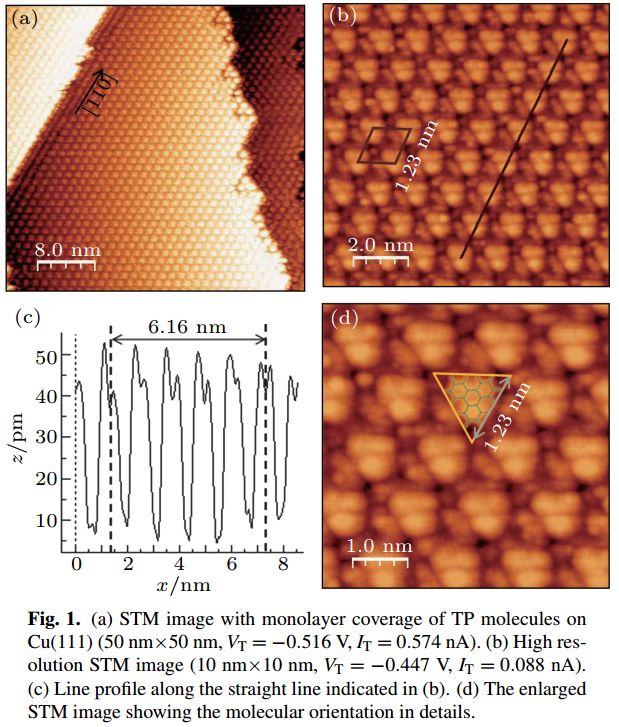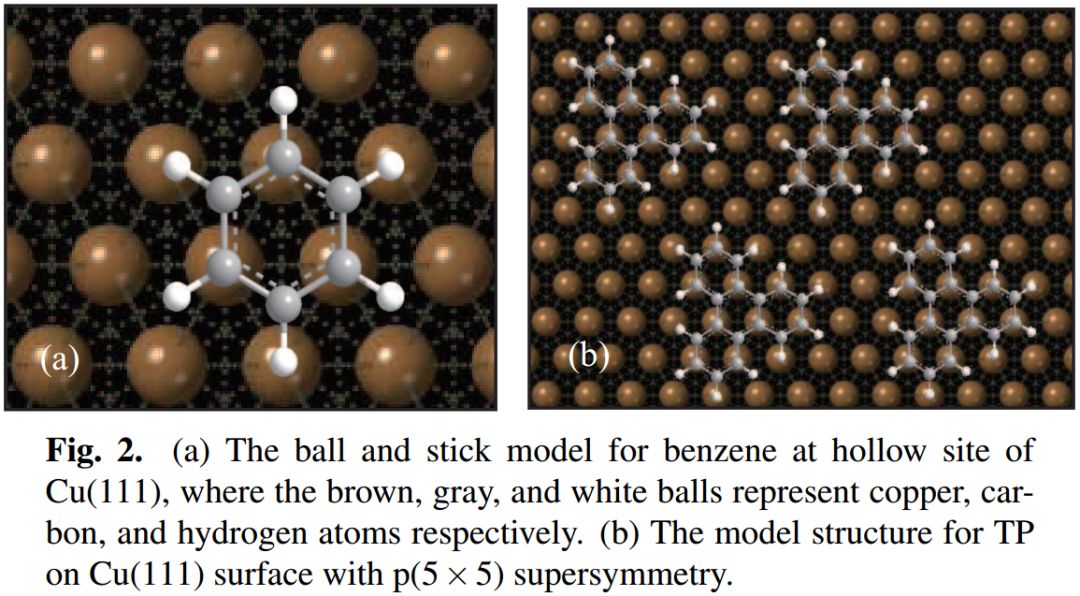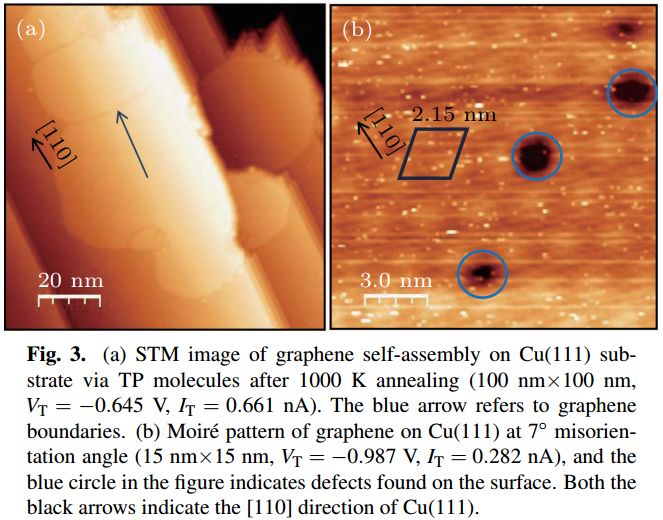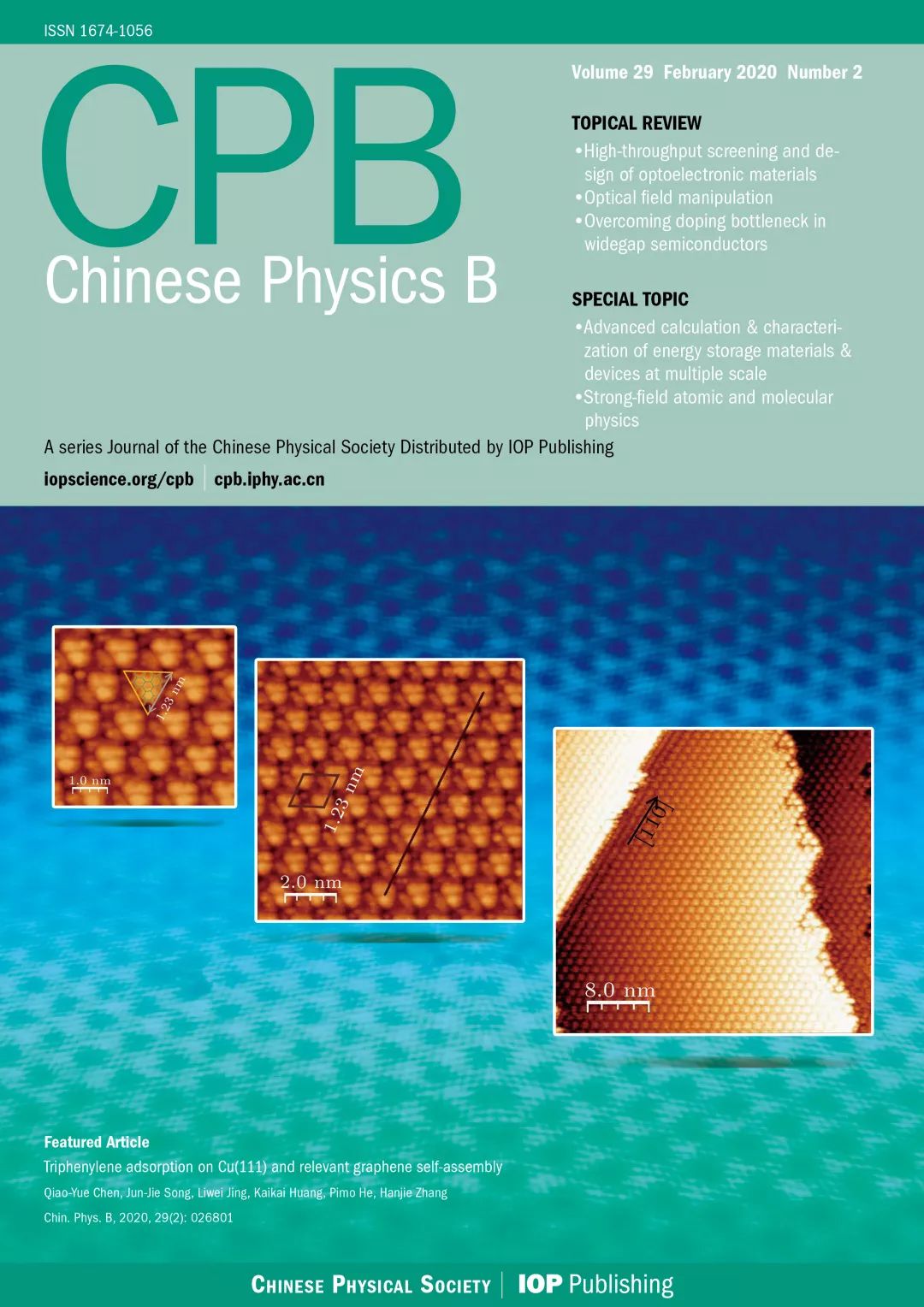博文
[转载]封面文章 | Triphenylene分子在Cu(111)表面自组装石墨烯生长行为研究
||
第一作者 | 陈乔悦 通讯作者 | 张寒洁,何丕模 CPB2020年第2期封面文章导读 Triphenylene分子在Cu(111)表面自组装石墨烯生长行为研究 研究亮点 本工作以Triphenylene(TP)分子为前体分子,在Cu(111)衬底上自组装生成石墨烯。利用扫描隧道显微镜,我们观察到了周期分别为2.93 nm,2.15 nm和1.35 nm的摩尔图案,分别对应石墨烯与Cu(111)衬底成4°,7°和10°位错角的情况,并对周期为2.93 nm和2.15 nm的摩尔图案进行了进一步模拟分析。 研究背景 作为新型二维碳纳米材料,石墨烯在诸多领域均有广泛的应用前景。其中铜是CVD生长石墨烯最常用的衬底之一,也是分子自组装生长石墨烯较为理想的选择。但是,目前人们对于石墨烯和铜衬底之间相互作用原理却了解很少,其中的一种探究方法就是通过分析石墨烯与铜衬底之间因为晶格错配而产生的超结构来获取更多的信息。目前实验主要观察到的是两种超结构:石墨烯与Cu(111)衬底呈0°位错角的摩尔图案(周期为~6.6 nm);石墨烯与Cu(111)衬底呈7°位错角的摩尔图案(周期为~2 nm)。10.4°位错角的摩尔图案在最近的实验中也有所发现,但对于本次实验所测得的石墨烯与Cu(111)衬底成4°位错角的情况之前并没有相应的实验数据作为支撑。 研究方法及结果 本工作中,作者以TP分子为前体分子,研究了其在Cu(111)衬底上的自组装石墨烯生长及其形成的摩尔图案。在覆盖度为一个单层的情况下,分子—分子之间排斥力和分子—衬底之间引力的微妙平衡促成了TP分子的二维液相生长而且形成了取向一致的长程有序结构。在对样品进行1000 K的高温退火后,表面形成了大规模的石墨烯。由于石墨烯与Cu(111)衬底之间较弱的结合能,使两者之间会有不同的位错角,从而呈现出不同的摩尔条纹。实验中主要观察到了石墨烯与Cu(111)衬底成三种不同位错角的摩尔图案,在结合了DFT(density functional theory)和CMD(classical molecular dynamics simulations)的计算结果后,我们得到了每个摩尔图案所对应的石墨烯与Cu(111)衬底之间的转角:摩尔图案周期~3 nm,θ≈4°;摩尔图案周期~2 nm,θ≈7°;摩尔图案周期~1.35 nm,θ≈10°。 研究意义或前景 本工作探究TP分子在Cu(111)衬底上自组装生长石墨烯的条件,对不同摩尔图案的分析有助于进一步研究Cu(111)表面石墨烯的相互作用关系,并提供了丰富的实验和数据支持。 文章来源 Chin. Phys. B, 2020, 29 (2): 026801 原文概览 Triphenylene adsorption on Cu(111) and relevant graphene self-assembly Qiao-Yue Chen(陈乔悦)1, Jun-Jie Song(宋俊杰)3, Liwei Jing(井立威)1, Kaikai Huang(黄凯凯)1, Pimo He(何丕模)1,2, Hanjie Zhang(张寒洁)1 1 Zhejiang Province Key Laboratory of Quantum Technology and Device, Department of Physics, Zhejiang University, Hangzhou 310027, China; Investigations on adsorption behavior of triphenylene (TP) and subsequent graphene self-assembly on Cu(111) were carried out mainly by using scanning tunneling microscopy (STM). At monolayer coverage, TP molecules formed a long-range ordered adsorption structure on Cu(111) with an uniform orientation. Graphene self-assembly on the Cu(111) substrate with TP molecules as precursor was achieved by annealing the sample, and a large-scale graphene overlayer was successfully captured after the sample annealing up to 1000 K. Three different Moiré patterns generated from relative rotational disorders between the graphene overlayer and the Cu(111) substrate were observed, one with 4° rotation between the graphene overlayer and the Cu(111) substrate with a periodicity of 2.93 nm, another with 7° rotation and 2.15 nm of the size of the Moiré supercell, and the third with 10° rotation with a periodicity of 1.35 nm. Keywords: triphenylene, graphene, Cu(111), scanning tunneling microscopy CPB专题推荐 SPECIAL TOPIC — Advanced calculation & characterization of energy storage materials & devices at multiple scale TOPICAL REVIEW — Advanced calculation & characterization of energy storage materials & devices at multiple scale TOPICAL REVIEW — Quantum dot displays SPECIAL TOPIC — A celebration of the 100th birthday of Kun Huang TOPICAL REVIEW — A celebration of the 100th birthday of Kun Huang SPECIAL TOPIC — Strong-field atomic and molecular physics TOPICAL REVIEW — Strong-field atomic and molecular physics TOPICAL REVIEW — Topological semimetals TOPICAL REVIEW — New generation solar cells TOPICAL REVIEW — Recent advances in thermoelectric materials and devices SPECIAL TOPIC — Amorphous physics and materials TOPICAL REVIEW — Soft matter and biological physics SPECIAL TOPIC — Nanophotonics SPECIAL TOPIC — Photodetector: Materials, physics, and applications SPECIAL TOPIC — Topological semimetals SPECIAL TOPIC — Photodetector: Materials, physics, and applications TOPICAL REVIEW — Nanolasers TOPICAL REVIEW — Physics research in materials genome TOPICAL REVIEW — Fundamental research under high magnetic fields SPECIAL TOPIC — 80th Anniversary of Northwestern Polytechnical University (NPU) TOPICAL REVIEW — Spin manipulation in solids TOPICAL REVIEW — Nanophotonics SPECIAL TOPIC — Nanophotonics TOPICAL REVIEW — SECUF: Breakthroughs and opportunities for the research of physical science TOPICAL REVIEW — Electron microscopy methods for emergent materials and life sciences TOPICAL REVIEW — Recent advances in thermoelectric materials and devices SPECIAL TOPIC — Recent advances in thermoelectric materials and devices TOPICAL REVIEW — Thermal and thermoelectric properties of nano materials TOPICAL REVIEW — Solid-state quantum information processing TOPICAL REVIEW — New generation solar cells SPECIAL TOPIC — New generation solar cells TOPICAL REVIEW — Soft matter and biological physics SPECIAL TOPIC — Soft matter and biological physics Virtual Special Topic — High temperature superconductivity Virtual Special Topic — Magnetism TOPICAL REVIEW — ZnO-related materials and devices TOPICAL REVIEW — Topological electronic states TOPICAL REVIEW — 2D materials: physics and device applications SPECIAL TOPIC — Amorphous physics and materials TOPICAL REVIEW — Amorphous physics and materials TOPICAL REVIEW — Physical research in liquid crystal
2 Collaborative Innovation Center of Advanced Microstructure, Nanjing University, Nanjing 210093, China;
3 Department of Fundamental and Social Science, Zhejiang University of Water Resources and Electric Power, Hangzhou 310018, China






https://wap.sciencenet.cn/blog-3377544-1233838.html
上一篇:[转载]CPB2020年第2期编辑推荐文章
下一篇:[转载]亮点文章 | 基于大栅金属高度的GaN沟道与AlGaN沟道HEMT器件击穿电压提升机理研究
